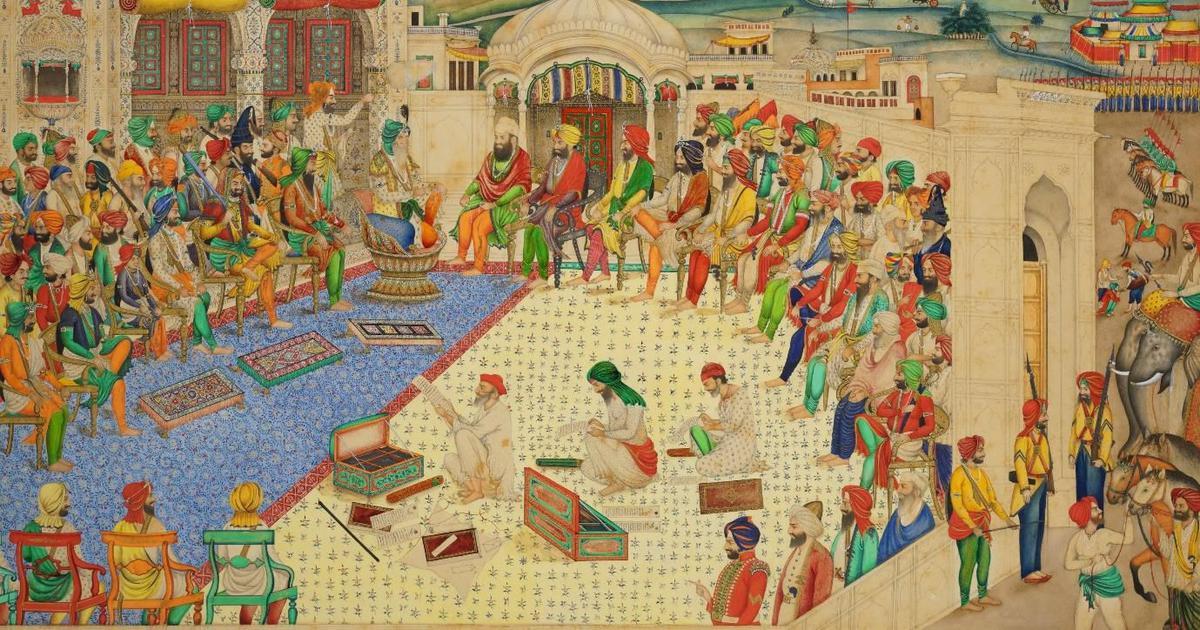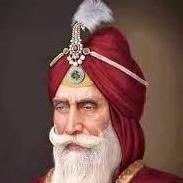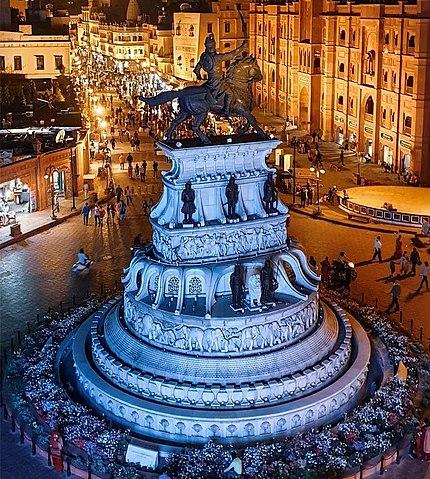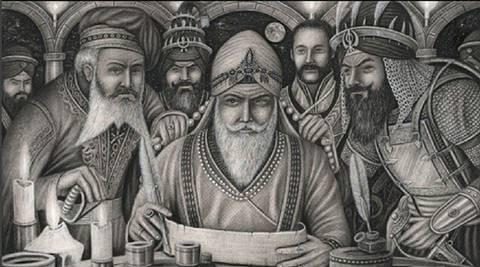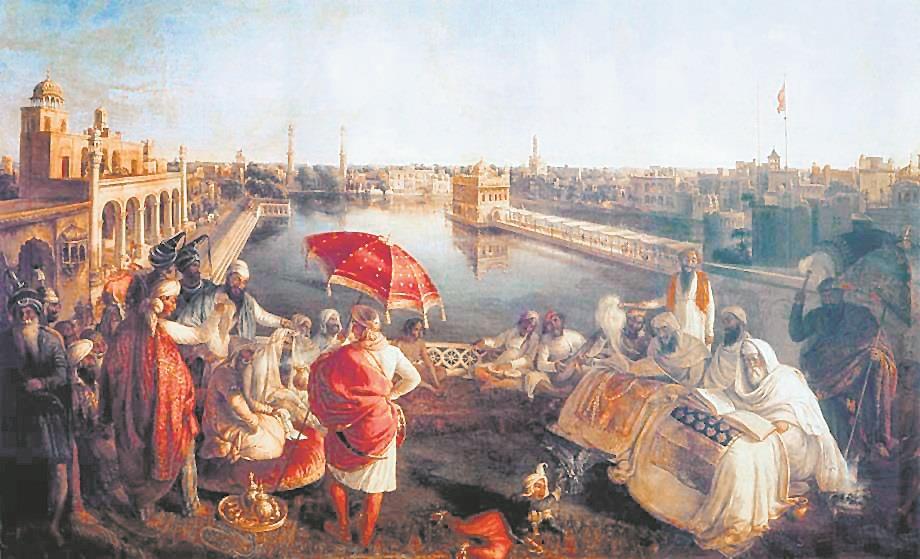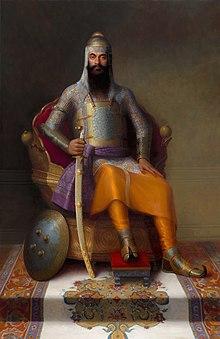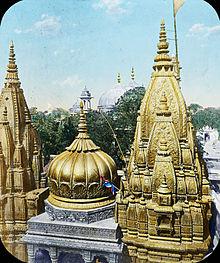Maharaja of Punjab
Maharaja of Lahore
Sher-e-Punjab (Lion of Punjab)
Sher-e-Hind (Lion of Hind)
Sarkar-i-Wallah (Head of State)[1]
Sarkar Khalsaji (Head of State)
Lord of Five Rivers
Singh Sahib
Maharaja of Lahore
Sher-e-Punjab (Lion of Punjab)
Sher-e-Hind (Lion of Hind)
Sarkar-i-Wallah (Head of State)[1]
Sarkar Khalsaji (Head of State)
Lord of Five Rivers
Singh Sahib
-
3 people like this
-
0 Posts
-
0 Photos
-
0 Videos
-
History and Facts
Recent Updates
-
Crafts:
In 1783, Ranjit Singh established a crafts colony of Thatheras near Amritsar and encouraged skilled metal crafters from Kashmir to settle in Jandiala Guru. In the year 2014, this traditional craft of making brass and copper products got enlisted on the List of Intangible Cultural Heritage by UNESCO. The Government of Punjab is now working under Project Virasat to revive this craft.Crafts: In 1783, Ranjit Singh established a crafts colony of Thatheras near Amritsar and encouraged skilled metal crafters from Kashmir to settle in Jandiala Guru. In the year 2014, this traditional craft of making brass and copper products got enlisted on the List of Intangible Cultural Heritage by UNESCO. The Government of Punjab is now working under Project Virasat to revive this craft.0 Comments 0 Shares 0 ReviewsPlease log in to like, share and comment! -
Memorials and museums:
Samadhi of Ranjit Singh in Lahore, Pakistan, marks the place where Singh was cremated, and four of his queens and seven concubines committed sati.
On 20 August 2003, a 22-foot-tall bronze statue of Singh was installed in the Parliament of India.
A museum at Ram Bagh Palace in Amritsar contains objects related to Singh, including arms and armour, paintings, coins, manuscripts, and jewellery. Singh had spent much time at the palace in which it is situated, where a garden was laid out in 1818.
On 27 June 2019, a nine-feet bronze statue of Singh was unveiled at the Lahore Fort at his 180th death anniversary.[139] It has been vandalised several times since, specifically by members of the Tehreek-e-Labbaik PakistanMemorials and museums: Samadhi of Ranjit Singh in Lahore, Pakistan, marks the place where Singh was cremated, and four of his queens and seven concubines committed sati. On 20 August 2003, a 22-foot-tall bronze statue of Singh was installed in the Parliament of India. A museum at Ram Bagh Palace in Amritsar contains objects related to Singh, including arms and armour, paintings, coins, manuscripts, and jewellery. Singh had spent much time at the palace in which it is situated, where a garden was laid out in 1818. On 27 June 2019, a nine-feet bronze statue of Singh was unveiled at the Lahore Fort at his 180th death anniversary.[139] It has been vandalised several times since, specifically by members of the Tehreek-e-Labbaik Pakistan0 Comments 0 Shares 0 Reviews -
Gurdwaras:
Perhaps Singh's most lasting legacy was the restoration and expansion of the Harmandir Sahib, the most revered Gurudwara of the Sikhs, which is now known popularly as the "Golden Temple".Much of the present decoration at the Harmandir Sahib, in the form of gilding and marblework, was introduced under the patronage of Singh, who also sponsored protective walls and water supply system to strengthen security and operations related to the temple. He also directed construction of two of the most sacred Sikh temples, being the birthplace and place of assassination of Guru Gobind Singh – Takht Sri Patna Sahib and Takht Sri Hazur Sahib, respectively – whom he much admired.Gurdwaras: Perhaps Singh's most lasting legacy was the restoration and expansion of the Harmandir Sahib, the most revered Gurudwara of the Sikhs, which is now known popularly as the "Golden Temple".Much of the present decoration at the Harmandir Sahib, in the form of gilding and marblework, was introduced under the patronage of Singh, who also sponsored protective walls and water supply system to strengthen security and operations related to the temple. He also directed construction of two of the most sacred Sikh temples, being the birthplace and place of assassination of Guru Gobind Singh – Takht Sri Patna Sahib and Takht Sri Hazur Sahib, respectively – whom he much admired.0 Comments 0 Shares 0 Reviews -
Legacy:
Singh is remembered for uniting Sikhs and founding the prosperous Sikh Empire. He is also remembered for his conquests and building a well-trained, self-sufficient Khalsa army to protect the empire. He amassed considerable wealth, including gaining the possession of the Koh-i-Noor diamond from Shuja Shah Durrani of Afghanistan, which he left to Jagannath Temple in Puri, Odisha in 1839.Legacy: Singh is remembered for uniting Sikhs and founding the prosperous Sikh Empire. He is also remembered for his conquests and building a well-trained, self-sufficient Khalsa army to protect the empire. He amassed considerable wealth, including gaining the possession of the Koh-i-Noor diamond from Shuja Shah Durrani of Afghanistan, which he left to Jagannath Temple in Puri, Odisha in 1839.0 Comments 0 Shares 0 Reviews -
Muslim accounts:
The mid 19th-century Muslim historians, such as Shahamat Ali who experienced the Sikh Empire first hand, presented a different view on Ranjit Singh's Empire and governance. According to Ali, Ranjit Singh's government was despotic, and he was a mean monarch in contrast to the Mughals. The initial momentum for the Empire building in these accounts is stated to be Ranjit Singh led Khalsa army's "insatiable appetite for plunder", their desire for "fresh cities to pillage", and entirely eliminating the Mughal era "revenue intercepting intermediaries between the peasant-cultivator and the treasury".
According to Ishtiaq Ahmed, Ranjit Singh's rule led to further persecution of Muslims in Kashmir, expanding[clarification needed] the previously selective persecution of Shia Muslims and Hindus by Afghan Sunni Muslim rulers between 1752 and 1819 before Kashmir became part of his Sikh Empire. Bikramjit Hasrat describes Ranjit Singh as a "benevolent despot". The Muslim accounts of Ranjit Singh's rule were questioned by Sikh historians of the same era. For example, Ratan Singh Bhangu in 1841 wrote that these accounts were not accurate, and according to Anne Murphy, he remarked, "when would a Musalman praise the Sikhs?" In contrast, the colonial era British military officer Hugh Pearse in 1898 criticised Ranjit Singh's rule, as one founded on "violence, treachery and blood". Sohan Seetal disagrees with this account and states that Ranjit Singh had encouraged his army to respond with a "tit for tat" against the enemy, violence for violence, blood for blood, plunder for plunder.Muslim accounts: The mid 19th-century Muslim historians, such as Shahamat Ali who experienced the Sikh Empire first hand, presented a different view on Ranjit Singh's Empire and governance. According to Ali, Ranjit Singh's government was despotic, and he was a mean monarch in contrast to the Mughals. The initial momentum for the Empire building in these accounts is stated to be Ranjit Singh led Khalsa army's "insatiable appetite for plunder", their desire for "fresh cities to pillage", and entirely eliminating the Mughal era "revenue intercepting intermediaries between the peasant-cultivator and the treasury". According to Ishtiaq Ahmed, Ranjit Singh's rule led to further persecution of Muslims in Kashmir, expanding[clarification needed] the previously selective persecution of Shia Muslims and Hindus by Afghan Sunni Muslim rulers between 1752 and 1819 before Kashmir became part of his Sikh Empire. Bikramjit Hasrat describes Ranjit Singh as a "benevolent despot". The Muslim accounts of Ranjit Singh's rule were questioned by Sikh historians of the same era. For example, Ratan Singh Bhangu in 1841 wrote that these accounts were not accurate, and according to Anne Murphy, he remarked, "when would a Musalman praise the Sikhs?" In contrast, the colonial era British military officer Hugh Pearse in 1898 criticised Ranjit Singh's rule, as one founded on "violence, treachery and blood". Sohan Seetal disagrees with this account and states that Ranjit Singh had encouraged his army to respond with a "tit for tat" against the enemy, violence for violence, blood for blood, plunder for plunder.0 Comments 0 Shares 0 Reviews -
Infrastructure investments:
Ranjit Singh ensured that Panjab manufactured and was self-sufficient in all weapons, equipment and munitions his army needed. His government invested in infrastructure in the 1800s and thereafter, established raw materials mines, cannon foundries, gunpowder and arm factories. Some of these operations were owned by the state, others operated by private Sikh operatives.
However, Ranjit Singh did not make major investments in other infrastructure such as irrigation canals to improve the productivity of land and roads. The prosperity in his Empire, in contrast to the Mughal-Sikh wars era, largely came from the improvement in the security situation, reduction in violence, reopened trade routes and greater freedom to conduct commerce.Infrastructure investments: Ranjit Singh ensured that Panjab manufactured and was self-sufficient in all weapons, equipment and munitions his army needed. His government invested in infrastructure in the 1800s and thereafter, established raw materials mines, cannon foundries, gunpowder and arm factories. Some of these operations were owned by the state, others operated by private Sikh operatives. However, Ranjit Singh did not make major investments in other infrastructure such as irrigation canals to improve the productivity of land and roads. The prosperity in his Empire, in contrast to the Mughal-Sikh wars era, largely came from the improvement in the security situation, reduction in violence, reopened trade routes and greater freedom to conduct commerce.0 Comments 0 Shares 0 Reviews -
Reforms:
Ranjit Singh changed and improved the training and organisation of his army. He reorganised responsibility and set performance standards in logistical efficiency in troop deployment, manoeuvre, and marksmanship. He reformed the staffing to emphasise steady fire over cavalry and guerrilla warfare, improved the equipment and methods of war. The military system of Ranjit Singh combined the best of both old and new ideas. He strengthened the infantry and the artillery. He paid the members of the standing army from treasury, instead of the Mughal method of paying an army with local feudal levies.
While Ranjit Singh introduced reforms in terms of training and equipment of his military, he failed to reform the old Jagirs (Ijra) system of Mughal middlemen. The Jagirs system of state revenue collection involved certain individuals with political connections or inheritance promising a tribute (nazarana) to the ruler and thereby gaining administrative control over certain villages, with the right to force collect customs, excise and land tax at inconsistent and subjective rates from the peasants and merchants; they would keep a part of collected revenue and deliver the promised tribute value to the state. These Jagirs maintained independent armed militia to extort taxes from the peasants and merchants, and the militia prone to violence. This system of inconsistent taxation with arbitrary extortion by militia, continued the Mughal tradition of ill treatment of peasants and merchants throughout the Sikh Empire, and is evidenced by the complaints filed to Ranjit Singh by East India Company officials attempting to trade within different parts of the Sikh Empire.
According to historical records, states Sunit Singh, Ranjit Singh's reforms focused on military that would allow new conquests, but not towards taxation system to end abuse, nor about introducing uniform laws in his state or improving internal trade and empowering the peasants and merchants. This failure to reform the Jagirs-based taxation system and economy, in part led to a succession power struggle and a series of threats, internal divisions among Sikhs, major assassinations and coups in the Sikh Empire in the years immediately after the death of Ranjit Singh;[118] an easy annexation of the remains of the Sikh Empire into British India followed, with the colonial officials offering the Jagirs better terms and the right to keep the system intact.Reforms: Ranjit Singh changed and improved the training and organisation of his army. He reorganised responsibility and set performance standards in logistical efficiency in troop deployment, manoeuvre, and marksmanship. He reformed the staffing to emphasise steady fire over cavalry and guerrilla warfare, improved the equipment and methods of war. The military system of Ranjit Singh combined the best of both old and new ideas. He strengthened the infantry and the artillery. He paid the members of the standing army from treasury, instead of the Mughal method of paying an army with local feudal levies. While Ranjit Singh introduced reforms in terms of training and equipment of his military, he failed to reform the old Jagirs (Ijra) system of Mughal middlemen. The Jagirs system of state revenue collection involved certain individuals with political connections or inheritance promising a tribute (nazarana) to the ruler and thereby gaining administrative control over certain villages, with the right to force collect customs, excise and land tax at inconsistent and subjective rates from the peasants and merchants; they would keep a part of collected revenue and deliver the promised tribute value to the state. These Jagirs maintained independent armed militia to extort taxes from the peasants and merchants, and the militia prone to violence. This system of inconsistent taxation with arbitrary extortion by militia, continued the Mughal tradition of ill treatment of peasants and merchants throughout the Sikh Empire, and is evidenced by the complaints filed to Ranjit Singh by East India Company officials attempting to trade within different parts of the Sikh Empire. According to historical records, states Sunit Singh, Ranjit Singh's reforms focused on military that would allow new conquests, but not towards taxation system to end abuse, nor about introducing uniform laws in his state or improving internal trade and empowering the peasants and merchants. This failure to reform the Jagirs-based taxation system and economy, in part led to a succession power struggle and a series of threats, internal divisions among Sikhs, major assassinations and coups in the Sikh Empire in the years immediately after the death of Ranjit Singh;[118] an easy annexation of the remains of the Sikh Empire into British India followed, with the colonial officials offering the Jagirs better terms and the right to keep the system intact.0 Comments 0 Shares 0 Reviews -
Khalsa Army:
The army under Ranjit Singh was not limited to the Sikh community. The soldiers and troop officers included Sikhs, but also included Hindus, Muslims and Europeans. Hindu Brahmins and people of all creeds and castes served his army, while the composition in his government also reflected a religious diversity. His army included Polish, Russian, Spanish, Prussian and French officers. In 1835, as his relationship with the British warmed up, he hired a British officer named Foulkes.
However, the Khalsa army of Ranjit Singh reflected regional population, and as he grew his army, he dramatically increased the Rajput and Jat Sikhs who became the predominant members of his army. In the Doaba region his army was composed of the Jat Sikhs, in Jammu and northern Indian hills it was Hindu Rajputs, while relatively more Muslims served his army in the Jhelum river area closer to Afghanistan than other major Panjab rivers.Khalsa Army: The army under Ranjit Singh was not limited to the Sikh community. The soldiers and troop officers included Sikhs, but also included Hindus, Muslims and Europeans. Hindu Brahmins and people of all creeds and castes served his army, while the composition in his government also reflected a religious diversity. His army included Polish, Russian, Spanish, Prussian and French officers. In 1835, as his relationship with the British warmed up, he hired a British officer named Foulkes. However, the Khalsa army of Ranjit Singh reflected regional population, and as he grew his army, he dramatically increased the Rajput and Jat Sikhs who became the predominant members of his army. In the Doaba region his army was composed of the Jat Sikhs, in Jammu and northern Indian hills it was Hindu Rajputs, while relatively more Muslims served his army in the Jhelum river area closer to Afghanistan than other major Panjab rivers.0 Comments 0 Shares 0 Reviews -
Religious policies:
As consistent with many Punjabis of that time, Ranjit Singh was a secular king and followed the Sikh path.His policies were based on respect for all communities, Hindu, Sikh and Muslim. A devoted Sikh, Ranjit Singh restored and built historic Sikh Gurdwaras – most famously, the Harmandir Sahib, and used to celebrate his victories by offering thanks at the Harmandir. He also joined the Hindus in their temples out of respect for their sentiments. The veneration of cows was promoted and cow slaughter was punishable by death under his rule. He ordered his soldiers to neither loot nor molest civilians.
He built several gurdwaras, Hindu temples and even mosques, and one in particular was Mai Moran Masjid, built on the behest of his beloved Muslim wife, Moran Sarkar. The Sikhs led by Singh never razed places of worship to the ground belonging to the enemy. However, he did convert Muslim mosques into other uses. For example, Ranjit Singh's army desecrated Lahore's Badshahi Mosque and converted it into an ammunition store,and horse stables. Lahore's Moti Masjid (Pearl Mosque) was converted into "Moti Mandir" (Pearl Temple) by the Sikh army,and Sonehri Mosque were converted into a Sikh Gurdwara, but upon the request of Sufi Fakir (Satar Shah Bukhari), Ranjit Singh restored the latter back to a mosque. Lahore's Begum Shahi Mosque was also used as a gunpowder factory, earning it the nickname Barudkhana Wali Masjid, or "Gunpowder Mosque."
Singh's sovereignty was accepted by Afghan and Punjabi Muslims, who fought under his banner against the Afghan forces of Nadir Shah and later of Azim Khan. His court was ecumenical in composition: his prime minister, Dhian Singh, was a Dogra; his foreign minister, Fakir Azizuddin, was a Muslim; and his finance minister, Dina Nath, was a Brahmin. Artillery commanders such as Mian Ghausa were also Muslims. There were no forced conversions in his time. His wives Bibi Mohran, Gilbahar Begum retained their faith and so did his Hindu wives.
Ranjit Singh had also provided significant patronage to the Udasi and Nirmala sect, leading to their prominence and control of Sikh religious affairs.Religious policies: As consistent with many Punjabis of that time, Ranjit Singh was a secular king and followed the Sikh path.His policies were based on respect for all communities, Hindu, Sikh and Muslim. A devoted Sikh, Ranjit Singh restored and built historic Sikh Gurdwaras – most famously, the Harmandir Sahib, and used to celebrate his victories by offering thanks at the Harmandir. He also joined the Hindus in their temples out of respect for their sentiments. The veneration of cows was promoted and cow slaughter was punishable by death under his rule. He ordered his soldiers to neither loot nor molest civilians. He built several gurdwaras, Hindu temples and even mosques, and one in particular was Mai Moran Masjid, built on the behest of his beloved Muslim wife, Moran Sarkar. The Sikhs led by Singh never razed places of worship to the ground belonging to the enemy. However, he did convert Muslim mosques into other uses. For example, Ranjit Singh's army desecrated Lahore's Badshahi Mosque and converted it into an ammunition store,and horse stables. Lahore's Moti Masjid (Pearl Mosque) was converted into "Moti Mandir" (Pearl Temple) by the Sikh army,and Sonehri Mosque were converted into a Sikh Gurdwara, but upon the request of Sufi Fakir (Satar Shah Bukhari), Ranjit Singh restored the latter back to a mosque. Lahore's Begum Shahi Mosque was also used as a gunpowder factory, earning it the nickname Barudkhana Wali Masjid, or "Gunpowder Mosque." Singh's sovereignty was accepted by Afghan and Punjabi Muslims, who fought under his banner against the Afghan forces of Nadir Shah and later of Azim Khan. His court was ecumenical in composition: his prime minister, Dhian Singh, was a Dogra; his foreign minister, Fakir Azizuddin, was a Muslim; and his finance minister, Dina Nath, was a Brahmin. Artillery commanders such as Mian Ghausa were also Muslims. There were no forced conversions in his time. His wives Bibi Mohran, Gilbahar Begum retained their faith and so did his Hindu wives. Ranjit Singh had also provided significant patronage to the Udasi and Nirmala sect, leading to their prominence and control of Sikh religious affairs.0 Comments 0 Shares 0 Reviews -
Governance:
Maharaja Ranjit Singh allowed men from different religions and races to serve in his army and his government in various positions of authority. His army included a few Europeans, such as the Frenchman Jean-François Allard, though Singh maintained a policy of refraining from recruiting Britons into his service, aware of British designs on the Indian subcontinent. Despite his recruitment policies, he did maintain a diplomatic channel with the British; in 1828, he sent gifts to George IV and in 1831, he sent a mission to Simla to confer with the British Governor General, William Bentinck; while in 1838, he cooperated with them in removing the hostile Islamic Sultan in Afghanistan.Governance: Maharaja Ranjit Singh allowed men from different religions and races to serve in his army and his government in various positions of authority. His army included a few Europeans, such as the Frenchman Jean-François Allard, though Singh maintained a policy of refraining from recruiting Britons into his service, aware of British designs on the Indian subcontinent. Despite his recruitment policies, he did maintain a diplomatic channel with the British; in 1828, he sent gifts to George IV and in 1831, he sent a mission to Simla to confer with the British Governor General, William Bentinck; while in 1838, he cooperated with them in removing the hostile Islamic Sultan in Afghanistan.0 Comments 0 Shares 0 Reviews
More Stories



